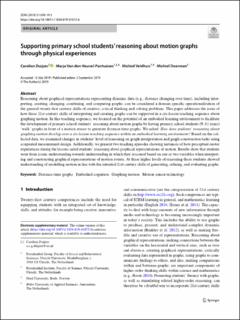Supporting primary school students' reasoning about motion graphs through physical experiences
Peer reviewed, Journal article
Published version

View/
Date
2019Metadata
Show full item recordCollections
Original version
Duijzer, C., Van den Heuvel-Panhuizen, M., Veldhuis, M. & Doorman, M. (2019). Supporting primary school students' reasoning about motion graphs through physical experiences. ZDM: Mathematics Education, 51, 899-913. doi: 10.1007/s11858-019-01072-6Abstract
Reasoning about graphical representations representing dynamic data (e.g., distance changing over time), including interpreting, creating, changing, combining, and comparing graphs, can be considered a domain-specific operationalization of the general twenty-first century skills of creative, critical thinking and solving problems. This paper addresses the issue of how these 21st century skills of interpreting and creating graphs can be supported in a six-lesson teaching sequence about graphing motion. In this teaching sequence, we focused on the potential of an embodied learning environment to facilitate the development of primary school students’ reasoning about motion graphs by having primary school students (9–11 years) ‘walk’ graphs in front of a motion sensor to generate distance-time graphs. We asked: How does students’ reasoning about graphing motion develop over a six-lesson teaching sequence within an embodied learning environment? Based on the collected data, we examined changes in students’ level of reasoning on graph interpretation and graph construction tasks using a repeated measurement design. Additionally, we present two teaching episodes showing instances of how perceptual-motor experiences during the lessons aided students’ reasoning about graphical representations of motion. Results show that students went from iconic understanding towards understanding in which they reasoned based on one or two variables when interpreting and constructing graphical representations of motion events. At these higher levels of reasoning these students showed understanding of modelling motion in line with the intended 21st century skills of generating, refining, and evaluating graphs.
